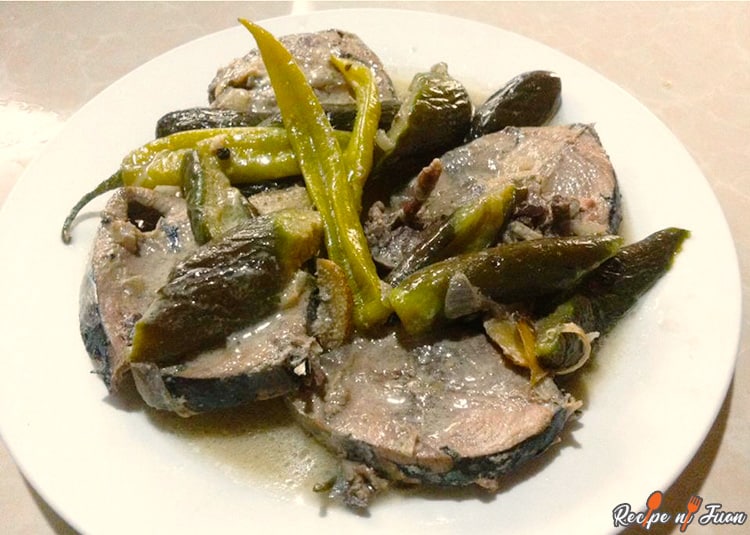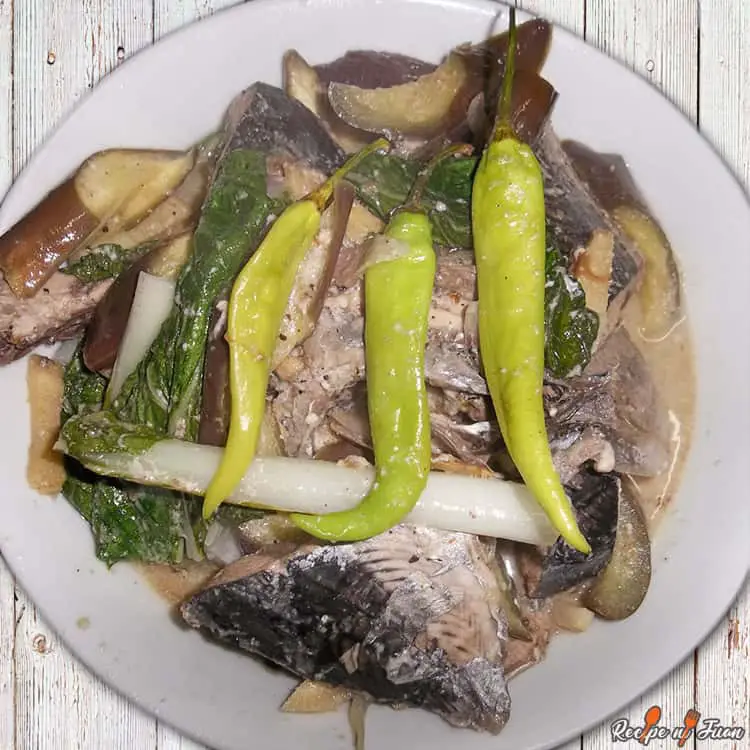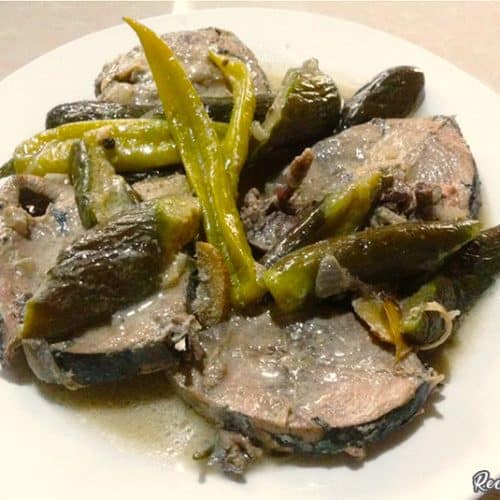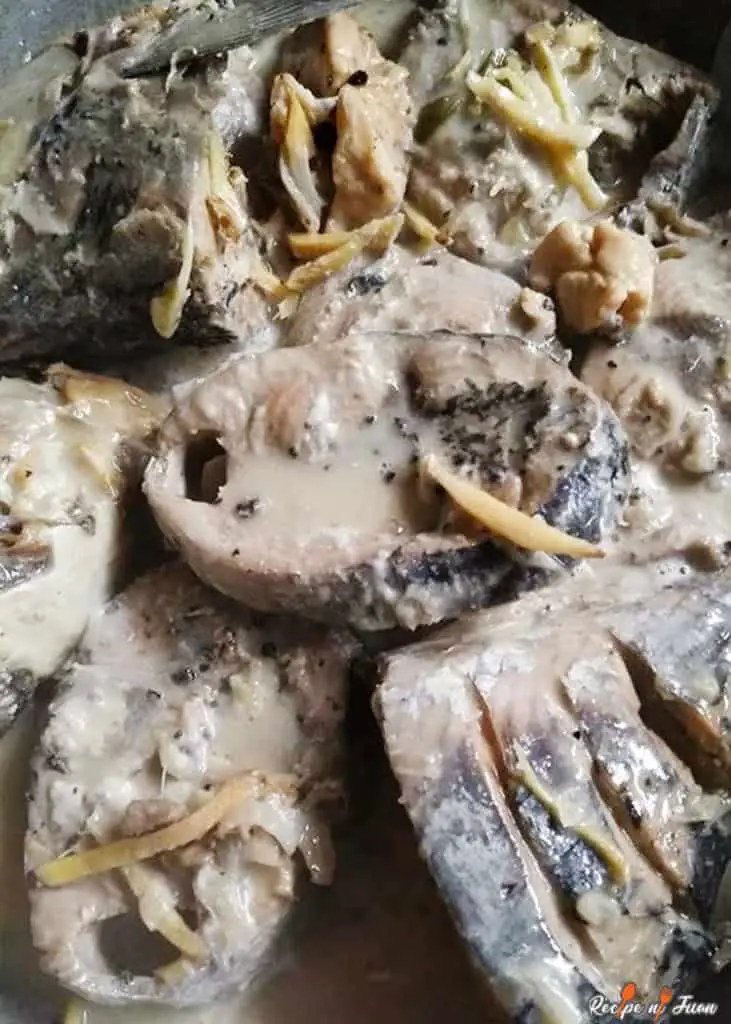Ginataang yellowfin tuna (or tambakol): A tasty recipe with creamy coconut!
Ginataang yellowfin tuna (or tambakol) is a variety of ginataan.
This is a creamy and tasty Filipino dish with so many varieties using all sorts of different ingredients, depending on what kind of ginataan is desired.
The ingredients are usually sautéed then cooked with coconut milk, or locally known by Filipinos as ginata. The ginataan adds a creamy, coconut flavor to the ingredients.
Most forms of ginataan are served with rice as viands, which are usually eaten for lunch or dinner.
The ginataang yellowfin is quite easy, simple to make, and very delicious too, once served!


Check out our new cookbook
Bitemybun's family recipes with complete meal planner and recipe guide.
Try it out for free with Kindle Unlimited:
Read for freeIn this post we'll cover:
Ginataang yellowfin tuna recipe and preparation tips
The ingredients necessary to cook ginataang yellowfin tuna are cut yellowfin tuna medallions (fillets), salt and pepper, chopped onions, crushed garlic, coconut milk, and cooking oil.
Once you’ve gathered the ingredients, you’re ready to start cooking ginataang yellowfin tuna.
- The first step to making ginataang yellowfin tuna is to heat a pan with cooking oil. Make sure the pan is hot to prevent the fish from sticking to the pan and ruining its look.
- The next step in cooking ginataang yellowfin is to then add crushed garlic in the pan and sauté the garlic until it’s got a golden-brown color to it. Be sure to check the sides of the yellowfin tuna to ensure that the fish is cooked.
- Afterward, once the garlic has a golden brown color to it, add the chopped onions into the pan and sauté it along with garlic. Once the onions turn slightly brown in color, you can then add coconut milk (ginata).
- After that, add some salt and pepper to add flavor to the ingredients.
- Once you’re done, the next step in making ginataang yellowfin tuna is to then mix the ingredients gently, and then simmer it until the coconut milk evaporates and becomes thick.
- After that, you’re ready to enjoy ginataang yellowfin tuna!
Also read: did you know you can make a ginataang with mais as well?


Ginataang yellowfin tuna recipe
Ingredients
- 1 medium tambakol (8–10 slices, including the head), a little less than 1kg
- 1 medium ginger sliced
- 2 shallots or onions sliced
- 2 bulbs garlic crushed
- 1 whole siling pang sigang (finger chili)
- 2 cups coconut cream (first extraction)
- ½ cup coconut milk (second extraction)
- ¼ cup vinegar
- 5 pcs mustasa (mustard leaves) optional
- salt and pepper to taste
Instructions
- Wash the tambakol thoroughly in running water. Remove the innards, such as the intestines and gills. Season the fish with salt.
- Layer the tambakol in a casserole dish. Put in the vinegar, ginger, shallots or onions, garlic, siling pang sigang (finger chili), and coconut milk. Cook on medium to high heat, covered.
- Bring to a boil, about 10 minutes. Pour in the coconut cream and simmer for 10-15 minutes.
- Season with salt and pepper to taste. Lay down the mustard leaves and cook for 5-7 minutes.
- Serve, share, and enjoy!
Notes
- If you want a spicier version, you may add siling labuyo (bird’s eye chili) after putting in the coconut cream.
- If you want a more intense flavor, you may fry the fish first before cooking it with coconut milk. You may also simmer it further to get an oilier sauce.
- NO STIRRING PLEASE. You may tilt the casserole dish back and forth to combine the ingredients. The reason for not stirring is the fish meat may break up when you stir.
- You may also replace the mustard leaves with malunggay, kangkong (water spinach), sitaw (string beans), sigarilyas (winged beans), or talong (eggplant). If you’re not into a vegetable, you may omit it.
- You may also replace the vinegar with 3/4 to 1 cup sliced kamias.
Nutrition

Cooking tips
When you get your fish, be sure to run it under clean cold water. If you’re cooking with fresh fish, you want to remove as much of the smell and any sticky coating.
The fish needs to be clean – the tummy and gills should be removed. Then, you have to slice the fish into medallions.
If you’re using frozen yellowfin tuna, you can skip this step and start cooking. Use regular-sized tambakol so you can cut it easily.
The yellowfin tuna is a large fish, so the medallions are the right size.
When seasoning the fish with salt and pepper, you should massage the condiments into the flesh gently. This ensures the fried fish is more flavorful and tastes better because fish can be rather bland.
Also, this extra step helps you get rid of any excess liquids from the tuna. This, in turn, prevents the oil splatter while you’re frying it.
When frying the tuna, only cook it halfway since it will cook in the coconut milk broth some more. You can add a bit more or a bit less coconut cream depending on the desired consistency.
It’s best to cook the broth and fish on medium heat because you don’t want the fish to crumble in the cooking pan.
Let the fish sit in the coconut broth so it absorbs that creamy, slightly sweet aroma.
When everything is set, your ginataang tambakol is done. Super easy, right? Enjoy this dish with a lot of hot steaming rice!
Substitutions and variations
This is one of those dishes that is made using specific ingredients.
If you substitute the tuna with another fish, it’s no longer ginataang tambakol! So, it’s best to use yellowfin tuna for this recipe.
But, if you really want to know “can I use another type of fish?”
Yes, you can use any other type of white-fleshed fish.
Here’s the thing, some Filipinos use larger chunks of the fish and the dish is just as delicious, rich, and bolder. You can do whatever you like.
Also, you need to use coconut milk and coconut cream if you want to make the real thing. If you use any other cream/milk combo, it just isn’t the same.
So, with the cream and fish, you can’t really use substitutions.
But, you can substitute the pechay leaves as these are hard to find sometimes. You can find them labeled as “bok choy” or “pak choy” but you can also use any leafy green you can find.
Napa cabbage, lettuce, celery, kale, spinach are all suitable and tasty options. Malunggay leaves are also quite popular but hard to get a hold of.
The Chinese cabbage (napa) is probably the best substitute but it has a rougher texture. However, the flavors are quite similar!
You can even experiment with eggplant or squash.
In some parts of the Philippines, a fruit called bilimbi is added to the stew and it adds a pleasantly sweet and sour flavor.
You can also play around with the spices.
You use red pepper flakes or chili flakes for a bit of spice but you can even add in some small spicy peppers, whole green chilies, or jalapeno to make this dish hot. My favorite is chopped hot chili!
What is ginataang yellowfin tuna?
Ginataang yellowfin tuna is a Filipino fish dish wherein yellowfin tuna is cooked in coconut milk. It is similar to pangat and binagoongan, except that it uses yellowfin tuna instead of shrimp or pork.
Usually, this type of ginataang dish has 3 main components: fish like tuna or tilapia, leafy vegetables, and coconut sauce.
It’s hard to find fresh yellowfin tuna at the regular grocery store – your best bet is to buy it frozen.
It’s a tasty fish dish but it’s more flavorful and rich because of the addition of coconut cream. Bitter melon leaves were the greens I used.
They are referred to in the Philippines as “dahon ng amplata” (ampalaya leaves). The extra punch of flavor comes from fish sauce and red pepper flakes or chili flakes.
The tuna needs to be pan-fried for a minute on both sides to partially cook it. This aids in the preservation of the fish’s form during the subsequent cooking process in coconut cream.
Make sure you cook your onions and ginger until they’re soft enough so that their natural flavors blend in seamlessly with any other ingredients you’re using.
As a result, this makes the coconut cream very flavorful and easy to consume.
This dish is usually served with steamed white rice and a dipping sauce made from vinegar, garlic, and chili peppers.
What is tambakol?
Tambakol is the Tagalog word for a type of tuna fish that is commonly found in the Philippines.
This saltwater sea fish known as “tambakol” is famous for its distinctive back stripes and forked tail. It is also known as skipjack tuna, yellowfin tuna, and mackerel tuna. Tulingan, barilis, and talingay are some of the most common local terms for it.
It is a popular ingredient in Filipino dishes and is often used as a filling for ensaymada.
But, you can, of course, cook it in a creamy sauce in the form of ginataang.
Tambakol’s soft flesh has a flavor that harkens back to the ocean.
Tambakol, like other large fish, can be prepared in a variety of different ways, according to local recipes. Paksiw, sinaing, tuna steak, and, of course, ginataang are just a few of the most popular dishes.
Origin
This dish is very popular in the Southern part of Luzon, in a place called Bicol because there are many coconut plantations there.
Thus, many regional dishes include some form of coconut since the area is full of coconut trees.
The dish is said to have originated in the Southern Philippines, specifically from the Mindanao region.
It is a popular dish among the Maranao people, who are known for their rich and flavorful cuisine.
Ginataang yellowfin tuna is one of those dishes that have been passed down from generation to generation and is now enjoyed by Filipinos all over the world.
How to serve and eat ginataang tambakol
Usually, ginataang tambakol is a popular lunchtime dish. It is served with a side of white rice. Be sure to serve hot because that’s the best way to enjoy stew-like dishes.
Steamed white rice is the most common and to make it taste better, there’s also a dipping sauce made from vinegar, garlic, and chili peppers.
Honestly, hot rice and creamy milky broth, with the fishy taste of tuna and fish sauce are all you need but I know some people prefer additional side dishes.
But are you wondering what are some good side dishes for ginataang?
Some good side dishes to pair with this dish include steamed vegetables or plain boiled cassava. You could also try serving it with fried ripe plantains.
Similar dishes
Similar dishes to ginataang tambakol are ginataang talakitok, ginataang hipon, and ginataang maya-maya.
Ginataang yellowfin tuna is a dish made with fresh or frozen yellowfin tuna simmered in coconut milk and spices. The dish is usually served with steamed rice.
Some ginataang dishes are sweetened with sugar, while others are enhanced with shrimp paste or fish sauce.
Ginataang bilo bilo is a sweet dessert like a soup made with coconut milk and tapioca. It’s worth a try if you want a fish-less ginataang.
FAQs
What is ginataang?
It is a term used in the Philippines to describe food that has been cooked with gatâ (coconut milk). Ginataang literally means “cooked with coconut milk” in Filipino.
As ginataan is so wide-ranging, it can be applied to a wide variety of dishes, all of which are called ginataan but are distinct from one another.
Many ginataang dishes are sweet desserts, although fish stews are popular too.
How large is tambakol?
The tambakol tuna is one of the larger tuna species. A whole fish has a size between 1.1kg to 1.3kg.
That’s why it’s best to cut it into circular pieces or use larger fillets for ginataang.
Is ginataang tambakol healthy?
Yes, this dish is relatively healthy as the tuna is low in calories and serves up about 400-500 calories per portion. Therefore, it’s not as unhealthy as fried fish.
While the dish does contain many carbs, especially with rice, it’s also high in protein.
Coconut milk and coconut cream contain some good fats, vitamins, and minerals.
Plus, the dish also contains some veggies so it’s not a bad lunch option.
Takeaway
Making ginataang tambakol is an easy way to cook and eat fish. The dish is healthy and delicious and can be made in under an hour.
If you’re looking for a new and exciting way to cook fish, then this recipe is definitely for you!
The creamier the sauce, the better! And, if you’re lucky enough to find fresh yellowfin tuna at the fishmonger, the fish texture will be out of this world!
Also check out this Sinuglaw Recipe (Sinugba and Kinilaw)
Check out our new cookbook
Bitemybun's family recipes with complete meal planner and recipe guide.
Try it out for free with Kindle Unlimited:
Read for freeJoost Nusselder, the founder of Bite My Bun is a content marketer, dad and loves trying out new food with Japanese food at the heart of his passion, and together with his team he's been creating in-depth blog articles since 2016 to help loyal readers with recipes and cooking tips.
